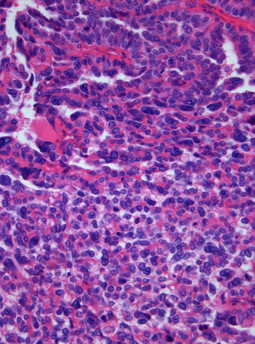Choroid plexus carcinoma
Editor-In-Chief: Prab R Tumpati, MD
Obesity, Sleep & Internal medicine
Founder, WikiMD Wellnesspedia &
W8MD medical weight loss NYC and sleep center NYC
| Choroid plexus carcinoma | |
|---|---|

| |
| Synonyms | Choroid plexus cancer |
| Pronounce | N/A |
| Specialty | N/A |
| Symptoms | Headache, nausea, vomiting, seizures, hydrocephalus |
| Complications | Metastasis, neurological deficits |
| Onset | Most common in children |
| Duration | Variable |
| Types | |
| Causes | Unknown, possibly genetic mutations |
| Risks | Li-Fraumeni syndrome, Aicardi syndrome |
| Diagnosis | MRI, CT scan, biopsy |
| Differential diagnosis | Choroid plexus papilloma, medulloblastoma, ependymoma |
| Prevention | None known |
| Treatment | Surgery, chemotherapy, radiation therapy |
| Medication | |
| Prognosis | Variable, generally poor |
| Frequency | Rare |
| Deaths | |
Choroid Plexus Carcinoma[edit | edit source]
Choroid Plexus Carcinoma is a rare, malignant tumor that arises from the choroid plexus in the ventricular system of the brain. It is classified as a central nervous system tumor and is most commonly found in children, although it can occur in adults.
Anatomy and Function of the Choroid Plexus[edit | edit source]
The choroid plexus is a network of cells that produces cerebrospinal fluid (CSF) in the ventricles of the brain. It plays a crucial role in maintaining the homeostasis of the central nervous system by regulating the composition of the CSF, which cushions the brain and spinal cord, removes waste, and provides nutrients.
Pathophysiology[edit | edit source]
Choroid Plexus Carcinoma is characterized by the uncontrolled proliferation of epithelial cells of the choroid plexus. This leads to the formation of a mass that can obstruct the flow of CSF, causing hydrocephalus and increased intracranial pressure. The tumor is highly aggressive and can metastasize to other parts of the central nervous system.
Clinical Presentation[edit | edit source]
Patients with Choroid Plexus Carcinoma may present with symptoms of increased intracranial pressure, such as headache, nausea, vomiting, and papilledema. In infants, signs may include macrocephaly and irritability. Neurological deficits may occur depending on the location and size of the tumor.
Diagnosis[edit | edit source]
Diagnosis of Choroid Plexus Carcinoma typically involves neuroimaging techniques such as MRI and CT scan to visualize the tumor. A definitive diagnosis is made through histopathological examination of a biopsy sample, which reveals atypical epithelial cells with high mitotic activity.
Treatment[edit | edit source]
The primary treatment for Choroid Plexus Carcinoma is surgical resection. Complete removal of the tumor is the goal, but it may be challenging due to the tumor's location and potential involvement with critical brain structures. Adjuvant therapy such as radiation therapy and chemotherapy may be employed to manage residual disease and reduce the risk of recurrence.
Prognosis[edit | edit source]
The prognosis for patients with Choroid Plexus Carcinoma varies depending on factors such as the extent of surgical resection, age at diagnosis, and response to adjuvant therapy. Overall, the prognosis is poor due to the aggressive nature of the tumor and its tendency to recur.
See also[edit | edit source]
| Oncology | ||||||||||
|---|---|---|---|---|---|---|---|---|---|---|
This oncology-related article is a stub.
|
Search WikiMD
Ad.Tired of being Overweight? Try W8MD's physician weight loss program.
Semaglutide (Ozempic / Wegovy and Tirzepatide (Mounjaro / Zepbound) available.
Advertise on WikiMD
|
WikiMD's Wellness Encyclopedia |
| Let Food Be Thy Medicine Medicine Thy Food - Hippocrates |
Translate this page: - East Asian
中文,
日本,
한국어,
South Asian
हिन्दी,
தமிழ்,
తెలుగు,
Urdu,
ಕನ್ನಡ,
Southeast Asian
Indonesian,
Vietnamese,
Thai,
မြန်မာဘာသာ,
বাংলা
European
español,
Deutsch,
français,
Greek,
português do Brasil,
polski,
română,
русский,
Nederlands,
norsk,
svenska,
suomi,
Italian
Middle Eastern & African
عربى,
Turkish,
Persian,
Hebrew,
Afrikaans,
isiZulu,
Kiswahili,
Other
Bulgarian,
Hungarian,
Czech,
Swedish,
മലയാളം,
मराठी,
ਪੰਜਾਬੀ,
ગુજરાતી,
Portuguese,
Ukrainian
Medical Disclaimer: WikiMD is not a substitute for professional medical advice. The information on WikiMD is provided as an information resource only, may be incorrect, outdated or misleading, and is not to be used or relied on for any diagnostic or treatment purposes. Please consult your health care provider before making any healthcare decisions or for guidance about a specific medical condition. WikiMD expressly disclaims responsibility, and shall have no liability, for any damages, loss, injury, or liability whatsoever suffered as a result of your reliance on the information contained in this site. By visiting this site you agree to the foregoing terms and conditions, which may from time to time be changed or supplemented by WikiMD. If you do not agree to the foregoing terms and conditions, you should not enter or use this site. See full disclaimer.
Credits:Most images are courtesy of Wikimedia commons, and templates, categories Wikipedia, licensed under CC BY SA or similar.
Contributors: Prab R. Tumpati, MD

